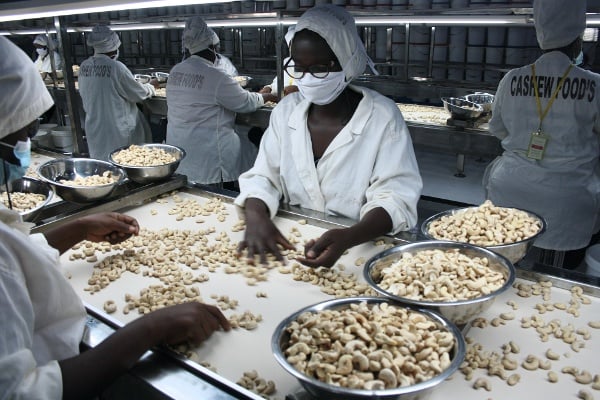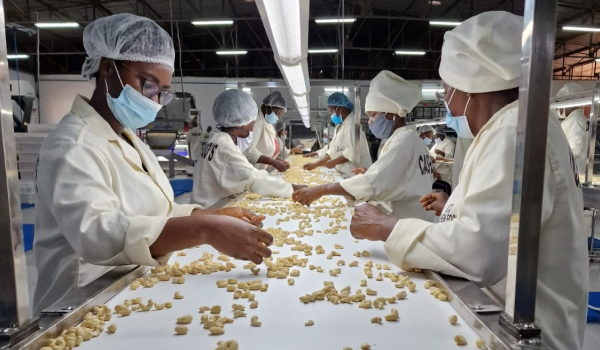Cashew nuts go through a lot of processing.
Not the type of processing that negatively affects your keto, vegan, and plant-based diet.
Cashew nuts undergo processing, making them an even better version of their natural selves. This is mostly because their natural selves can be very harmful to you. But just like with diamonds, there’s a gem underneath.
"The objective in processing cashew nuts is to remove the highest possible weight of kernels from the nut in-shell, unbroken and with the distinctive light ivory cashew color. It is a food product so the taste should remain as natural as possible and the process should be done in a safe manner."[1]
To get a much deeper look into how raw cashew nuts are processed, we need to examine 5 vital cashew nut processing steps. This will help you appreciate the value placed on cashew nuts, their health benefits, and possibly their pricing, too.
Cashew processing is traditionally divided into five broad steps: [1]
Each of these steps comprises a variety of processes, stages, and options that differ from one area to the other (e.g., Vietnam, India, Brazil, Africa).[1] Here, we’ll focus on the way Cashew Coast processes its cashews.
Let’s get straight into the 5 steps:

1. Preparation
Cashew starts as an apple. Shaped like a pepper, each cashew apple falls on the ground before being hand-picked by farmers (usually women) to remove the single raw cashew attached. We’ve inserted an image below so that you can visualise what it looks like.
.jpg?width=600&height=600&name=Cashew-Processing-Raw-Cashew-Nut-with-apple%20(600px).jpg)
See the attachment hanging at the base of the apple? That’s the cashew nut in its raw form. The farmers collect it in buckets and send it to the village for drying.
Sun-Drying of the raw cashew nuts
.jpg?width=600&height=900&name=cashew-processing-sun-drying%20(600px).jpg)
During harvest time in Côte d’Ivoire, it’s pretty commonplace to find drying cashews in the middle of the village. The local chickens also play an important job pecking away insects that may have found their way to the raw cashews.
At Cashew Coast, we train our farmers in the best picking and drying techniques to produce the highest-quality raw nuts.
After this, it’s off to the warehouse. This gives the cashew a safe place to be processed throughout the year.
It’ll be safe from pathogens and insects. In other words, it ensures the cashews are in their best shape throughout the year before processing. Remember, the year’s cashews are bought between February and May and gradually processed until the next campaign.
Did you know: at Cashew Coast, we give each cashew fruit a face. We do this by tracing back its origins from the village and the farmer it came from. We give the cashew a special code to remember it and it helps our customers to know where their food comes from exactly.
When the Raw Cashew Nuts (RCN) arrive at the factory, they are sun-dried for 2 to 3 days. Preferably done on a concrete apron, drying aims to reduce the amount of moisture in cashew nuts to about 8%.[1] This stops them from forming moulds, which then cause rotting while they are being stored.
.jpg?width=600&height=450&name=cashew-processing-stockage-RNC%20(600px).jpg)
When harvesting, the raw nuts may contain 12 to 16% moisture. Since raw nut processing is an activity spread over different months, storing the nuts 6 to 12 months before processing is necessary. To prevent damage to kernels during storage, the moisture content of the raw nut is to be kept below a certain critical level.[2]
After reaching the optimal moisture level, raw cashew nuts are stored in the warehouse, awaiting further processing.
Calibration & Cleaning
The more technical aspects of the processing start with calibration and cleaning. It’s when the nuts are sorted and grouped by size while foreign matter is removed.
Did you know: Raw nuts may contain dust, sand, small stones, twigs, other foreign matters etc. and they are to be removed first. The nuts are passed through a sieve to remove such particles. Large objects are removed manually.[2]
The calibrator divides the nuts into different grades by size, usually 18mm, 20mm, 22mm, and 24mm. Still, some machines will grade into five or eight different sizes with capacities ranging from 500kg to 2 tonnes per hour.[1]
Calibration is important for selecting the right blade for the shelling machines later in the process. The more precise the blade, the fewer breakages.
Heat treatment
.jpg?width=600&height=450&name=cashew-processing-post-steaming-airing%20(600px).jpg)
Once calibrated, the cashew nuts must undergo heat treatment. Often referred to as “cooking” or “roasting”, this step involved steam-boiling the nuts to weaken their tough shell ahead of de-shelling.
The purpose of roasting is to prepare the nuts for shelling and to extract the kernels without breaking and CNSL contamination to kernels.[2]
While other methods exist, such as drum or oil bath roasting [1, 2], Cashew Coast has chosen to use steam instead. It allows for finer temperature control, avoids desiccating the nuts, and prevents worker exposure to acidic fumes.[2]
The steamed cashews are then left to air dry.
2. Shelling (shell removal & separation)
.jpg?width=600&height=450&name=cashew-processing-mechanical-shelling%20(600px).jpg)
Shelling, also referred to as de-shelling, is at the heart of cashew processing. It consists in breaking and removing the outer shell, or husk, of the cashew nut, without ever (well, almost ever) splitting the precious whole kernel.
This is where the process may get complicated. All shelling machines, no matter what type, depend on properly adjusting the blades and the chutes or pipes properly calibrated.[1]
Traditionally, shelling is done manually. While this ensures greater precision and, thus, less splitting, the cashew husk contains a caustic phenolic resin, which can cause serious skin damage to workers.[3] [4] [5]
Did you know: cashew nuts have two shells, one on the outside called pericarp or epicarp, and another one in the inside called endocarp [6]. The pericarp is is smooth, somewhat elastic and olive-green in colour before maturity when it becomes grayish-brown [6]. The endocarp is brown and hard, and must be cracked like the shells of other nuts [6]. The shell represents 2/3 of the weight of the raw nut [2]. These two shells are separated by a cavity structured similarly to honeycombs.[5] [6]
The caustic substance, called Cashew Nut Shell Liquid (or CNSL for short), is a viscous liquid greenish-yellow in colour[7] that turns reddish-brown after industrial extraction.[6]
The four main compounds of CNSL are: [6] [8]
• Anacardic Acid (otherwise known as cashew acid).
• Cardanol
• Cardol
• 2-methyl cardol
CNSL is a highly corrosive chemical that can cause burns and blisters on the hands of workers [5; 9; 10], so de-shelling requires many precautions [2]. Unfortunately, too many companies are still not addressing the problem.[11] [12]
At Cashew Coast, we use automatic shelling machines.
Once freed from the shell, the kernel must be freed from the testa.
3. Peeling (removal of testa)
In its natural state, the kernel is covered with a thin brown seed coat called testa, which must also be removed.[6]
Following shelling, the cashew kernel must be dried to reduce moisture and loosen the testa.[2] This can be achieved through various sources, such as a steam boiler fuelled by cashew nut shells, electricity, or oil.[1]
Hot chamber treatment
.jpg?width=600&height=338&name=cashew-processing-borma-hot-chamber%20(600px).jpg)
At Cashew Coast, our kernels are placed on trays (100 cm x 50 cm x 10 cm) with wire mesh bottoms and loaded into metallic chambers called Borma, oven-dried at 80°C [2]. Each tray can hold about 7 to 10 kg of kernel.[2]
This process is crucial for loosening the testa surrounding the kernel. Rendering the testa brittle facilitates easy peeling, thereby minimizing breakage.[1]
Additionally, it aids in eliminating any remaining Cashew Nut Shell Liquid (CNSL) that may have permeated the nut during the previous stage.
Did you know: Like all plants of the anacardiaceae family such as poison ivy, poison oak, poison sumac, Peruvian pepper, pistachio and mango, cashews contain an irritant called urushiol that can cause a rash to people who are allergic.[13] Heat treatment helps deactivate urushiol.
Humidification
.jpg?width=600&height=437&name=cashew-processing-humidification%20(600).jpg)
After oven drying, the kernels are gently humidified with steam or lightly sprayed with water to prevent them from becoming too brittle. Preparation for peeling is a delicate process because while you want the testa to be brittle and loosen for easy removal, you don’t want the kernels to become too dry.
Steam aids in peeling but can sometimes affect the kernel's colour. On the other hand, spraying helps maintain the kernel's white colour but is not as effective for peeling.
Peeling
.jpg?width=600&height=800&name=cashew-processing-mechanical-peeling%20(600px).jpg)
Once the kernel is deemed peelable, the testa is removed. The traditional method was done manually by gently rubbing them between the fingers and finishing the process with a small knife.[1]
At Cashew Coast, though, peeling is done by machines that use air pressure and friction to blow off the testa. Again, the utmost precaution is taken to break as few wholes as possible.
Did you know: Maintaining hygienic practices is essential for producing high-quality kernels. Peeling operations are conducted using sanitized equipment and utensils to prevent any potential physical, chemical, or biological contamination.[2]
At this stage, the kernel is taken through quality control.
4. Grading & Inspection
.jpg?width=600&height=450&name=cashew-processing-manual-grading%20(600px).jpg)
This is an important part of cashew processing, where the kernels are graded and sorted based on size, colour, and shape using colour sorters and optical machinery. But there is no better sorter than the human eye and brain, hence a final round of eagle-eyed manual grading completes this process.
Did you know: Grading requires great skill. On an average one person can grade 80kg of kernels in 8 h/day. Black spots if any on the kernel will be removed with the help of a knife.[2]
As cashew kernels have this odd boomerang shape and depending on the "peelability" of the testa, human intervention becomes key to finishing peeling some kernels. At Cashew Coast, we call our peeling ladies the “undefeatables”!
.jpg?width=600&height=450&name=cashew-processing-colour-sorter%20(600px).jpg)
While grade classifications are crucial for compliance with the standards set by the Association of Food Industries, it's worth noting that the specifications for cashew nuts were initially established in India in the 1960s [2] and may not always be relevant to the expectations of 21st-century European or American consumers. Cashew Coast provides our clients with a functional lens for these grades.
Did you know: Grade specifications of Indian cashew kernels for export have been laid down by the Govermnent of India under the Export (Quality Control and Inspection) Act 1963. The Act prescribes 33 different grades of cashew kernels.[2]
At Cashew Coast, we also believe that premium cashews are not the whitest and roundest but the most traceable. They are not issued from deforestation and child labour and happen to be crunchy and creamy, as they are sourced and processed locally!
5. Packing & Storage
After the grading & inspection process, the kernels are prepared to be packed.
.jpg?width=600&height=450&name=cashew-processing-thermal-treatment%20(600px).jpg)
They first undergo antimicrobial treatment to eliminate or deactivate pathogens such as Salmonella, Aflatoxins, E. coli, or Listeria. Such treatment—which includes thermal and ultraviolet (UV) processing—is critical because a very low level of contamination could result in serious disease [14].
Did you know: Thermal treatment for food preservation were developed in the 18th and 19th centuries, notably by French microbiologist Louis Pasteur in the 1860ies [15]. Named after him, the process referred to as Pasteurisation is a mild heat treatment, usually less than 100 °C, which destroys, deactivates or brings down to a safe level potentially dangerous microbes and spoilage organisms such as mold [16] [17]. It also extends the product shelf life by decreasing the rate of lipid oxidation during storage [18]. Typical pasteurisation conditions should be no less than 71.7 °C for at least 15 s (High-Temperature, Short-Time - HSTS) pasteurization.[19]
In order to preserve the original quality, Cashew Coast kernels are progressively heated by Infrared lamps (IR) to reach 75°C after 4 minutes. They are then subjected to UV lights, and, finally, they are gently cooled down to 30°C/35°C so they can be packed rapidly.
UV treatment has been proven to preserve quality and minimize nutrient degradation [20] [21], with the UV-C sub-band accounting for much of its microbicide action.[22] [23]
The kernels go through X-ray and metal detector machines to ensure that the product is free of any foreign matter. The final step involves a CO2 treatment to complete the antimicrobial processing.[24]
.jpg?width=600&height=450&name=cashew-processing-x-ray-machine%20(600px).jpg)
The kernels are then packed in 50 lbs cubic vacuum-sucked Flexi pouches by grade and labeled with a lot of code for traceability. The moisture is kept at 4% so they don’t break in packaging.
.jpg?width=600&height=450&name=cashew-processing-vacuum-packing%20(600px).jpg)
So there! All 5 steps of the processing of raw cashew nuts.
At the Cashew Coast, we follow these steps religiously to ensure that all the cashews are safe for consumption, nutritious, and in perfect shape by the time they reach your local grocery store.
Our team will tell you how challenging it is to keep cashews whole throughout the process.
Were you aware of these steps?
Share this article with a friend to create awareness about how cashew nuts are processed.
.jpg?width=600&height=400&name=cashew-processing-kernel-boxes-ready-for-shipping%20(600px).jpg)
Sources & References
[1] Fitzpatrick, J. (2011) Cashew Nut Processing Equipment Study – Summary. Deutsche Gesellschaft für Internationale Zusammenarbeit (GIZ) GmbH International Foundations. African Cashew Initiative (ACI).
[2] Abdul Salam, M. & Peter, K.V. (2010) Cashew, A Monography. Stadium Press, India. ISBN: 978-93-80012-08-7
[3] Srinivas, C. R., & Pasricha, J. S. (1990) Dermatological problems of workers employed in cashew nut factories. Contact dermatitis, 22(3), 192.
[4] Rosen, T., & Fordice, D. B. (1994) Cashew nut dermatitis. Southern medical journal, 87(4), 543–546. https://doi.org/10.1097/00007611-199404000-00026
[5] Andonaba, J.-B.,Lompo, S.S., Ouédraogo, V., Ouédraogo, F.,Ouédraogo, M.S., Konaté, I., Diallo, B. andTraoré, A. (2017) Skin Damage and Aesthetic Disadvantage Observed in Women in the Hand Craft Shelling Chain of Cashew Nuts in a Factory to Bobo-Dioulasso, Bur-kina Faso. Journal of Cosmetics, Derma-tological Sciences and Applications, 7,211-220. https://doi.org/10.4236/jcdsa.2017.73020
[6] Lubi, M.C. & Thachil, E.T. (2000) Cashew nut shell liquid (CNSL) -
a versatile monomer for polymer synthesis. Designed Monomers and Polymers, 3:2, 123-153. https://doi.org/10.1163/156855500300142834
[7] Harvey, M. T. & Caplan, S. (1940) Cashew Nut Shell Liquid. Ind. Eng. Chem. 1940, 32, 10, 1306–1310, October 1, 1940. https://doi.org/10.1021/ie50370a008
[8] Gedam, P.H. & Sampathkumaran, P.S. (1986) Cashew nut shell liquid: Extraction, chemistry and applications. Progress in Organic Coatings, Volume 14, Issue 2, 13 October 1986, Pages 115-157. https://doi.org/10.1016/0033-0655(86)80009-7
[9] Lamble, L. (2013) Cashew nut workers suffer 'appalling' conditions as global slump dents profits. The Guardian, 2 Nov 2013.
[10] Wilson, B. (2015) Blood cashews: the toxic truth about your favourite nut. The Telegraph, 4 May 2015.
[11] Clark, E. (2019) Hidden agony behind our craze for cashews: How thousands of Indian nut processors on £2.15 a day are left with 'unbearable' burns from acid in the shells of the superfood. Daily Mail, 3 April 2019.
[12] Brody , P. (2023) What is ‘cashew oil’ and why is it disfiguring Kenyan workers’ hands? France 24 – Observers, 18 January 2023.
[13] Stierwalt, S. (2020) What Do Cashews, Mangoes and Poison Ivy Have in Common? Scientific American, January 26, 2020.
[14] Ivarsson, C. (2018) Food Safety and Pasteurisation of Cashews. Cashew Week, Volume 19, Issue 3.
[15] Tewari, G. & Juneja, V.K. (2007) Advances in Thermal and Non-Thermal Food Preservation. Wiley-Blackwell. ISBN: 9780813829685. https://doi.org/10.1002/9780470277898
[16] Ivarsson, C. (2013) Validation of processes for reducing the microbial load on nuts, Editor(s): Linda J. Harris, In Woodhead Publishing Series in Food Science, Technology and Nutrition, Improving the Safety and Quality of Nuts, Woodhead Publishing, 2013, Pages 148-170, ISBN 9780857092663. https://doi.org/10.1533/9780857097484.1.148
[17] Ivarsson, C. (2021) Pasteurisation: Food safety for nuts. Food & Beverage Asia, August / September 2021.
[18] Luo, K., Chapman, D., Huang, G. & Mitchell, A. (2022) Effect of Pasteurization on Raw Almond (Prunus dulcis) Oxidation during Storage. ACS Food Science & Technology 2022 2 (2), 260-271. https://doi.org/10.1021/acsfoodscitech.1c00376
[19] Silva, F.V.M., Gibbs, P.A. , Nuñez, H. , Almonacid, S., & Simpson, R. (2014) Thermal Processes | Pasteurization, Editor(s): Carl A. Batt, Mary Lou Tortorello, Encyclopedia of Food Microbiology (Second Edition), Academic Press, 2014, Pages 577-595, ISBN 9780123847331. https://doi.org/10.1016/B978-0-12-384730-0.00404-3
[20] Koutchma, T. (2008). UV Light for Processing Foods. Ozone Science and Engineering. 30. 93-98. https://doi.org/10.1080/01919510701816346
[21] Yemmireddy, V., Adhikari, A. & Moreira, J. (2022) Effect of ultraviolet light treatment on microbiological safety and quality of fresh produce: An overview. Frontiers in Nutrition, Volume 9. https://doi.org/10.3389/fnut.2022.871243
[22] Jubeen, F., Bhatti, I., Khan, M., Hassan, Z. & Shahid, M. (2012) Effect of UVC Irradiation on Aflatoxins in Ground Nut (Arachis hypogea) and Tree Nuts (Juglans regia, Prunus duclus and Pistachio vera). Journal of the Chemical Society of Pakistan. 34. 1366-1374.
[23] Sánchez-Bravo, P., Noguera-Artiaga, L., Gómez-López, V. M., Carbonell-Barrachina, Á. A., Gabaldón, J. A., & Pérez-López, A. J. (2022) Impact of Non-Thermal Technologies on the Quality of Nuts: A Review. Foods (Basel, Switzerland), 11(23), 3891. https://doi.org/10.3390/foods11233891
[24] Fuchs, K. (2020) Decontaminating almonds and nuts with compressed carbon dioxide. Fraunhofer-Gesellschaft, Research News, 01 December 2020.
[25] Saroj, P.L. & Swamy, K.R.M. (2017) The Cashew. Indian Council of Agricultural Research. New Delhi.




